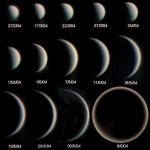tenex
reality-based
Venus is a lovely thin crescent now. In any binocular (or at 20x in our recently acquired S2 scope) I can tell that it's a crescent, but it looks fairly thick, like a quarter moon. Only at higher magnification does it become clear how very slender the crescent has become. Why is this? It reminds me of how ~50x is also necessary to see a clear gap between the rings and disk of Saturn, although that strikes me as a rather different situation.
Unfortunately we're clouded out tonight, and probably tomorrow too...
Unfortunately we're clouded out tonight, and probably tomorrow too...






